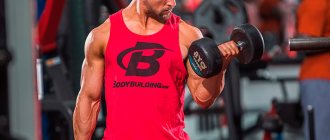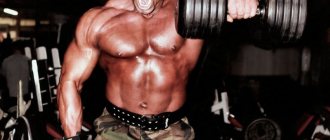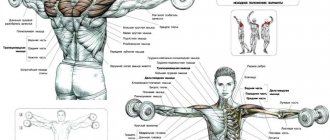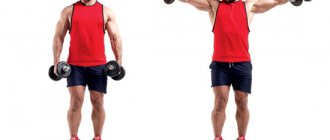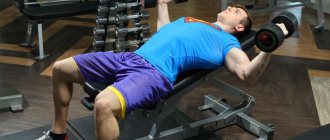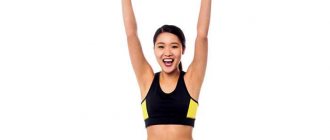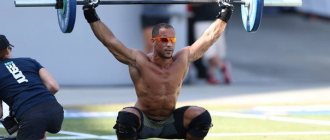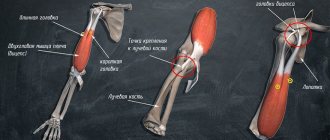Technique
The exercise will have the desired result when the dumbbell raises are performed in accordance with the correct technique.
At the same time, using even a small weight when performed in a high-quality form will yield results. This is a better option than large dumbbells, but is not performed correctly.
Lifting dumbbells through the sides is performed as follows:
- You need to place your feet shoulder-width apart, bend them slightly at the knees. In this case, the torso is slightly tilted, the back is bent;
- take dumbbells in your hands, bend your elbows slightly;
- inhale while simultaneously moving the dumbbells in different directions;
- Exhale as you lower the dumbbells.
This exercise has many alternatives. As you can see in the photo of lifting dumbbells, the technique can be performed with support on the chest, or lying on an inclined bench.
One of the most popular exercises today is the fly. Apart from the adjustments that everyone makes at their own discretion, the technical methodology remains the same for all athletes and amateurs.
Raising dumbbells overhead from the sides
Raising dumbbells overhead through the sides engages the middle deltoids, as well as the supraspinatus and trapezius muscles.
This shaping exercise broadens the shoulders and gives them a defined shape. Raising dumbbells overhead from the sides targets the middle fascicles of the deltoid muscle, the development of which visually widens and raises the shoulders. This exercise effectively highlights the middle deltoids, against the background of other bundles of the deltoid muscle, trapezius and triceps. In addition, lateral raises of dumbbells improve the mobility of the shoulder joint and strengthen the shoulder girdle as a whole. Exercise technique:
- Place your feet shoulder-width apart and straighten your torso. In the starting position, the arms are slightly bent and fixed at the elbows until the end of the set, the dumbbells almost touch the hips (palms facing the lateral surface of the thigh).
- Inhale and, holding your breath, raise your arms through your sides (strictly in the plane of your torso) above your head.
- When the dumbbells pass shoulder level, the arms turn slightly at the shoulder joint and at the top of the palm are directed forward. However, if it is uncomfortable for you to continue the movement when your arms become parallel to the floor and the dumbbells “get stuck,” turn your arms more strongly - palms up. In this case, at the top point the palms face each other.
- Do not relax your lower back and maintain a straight body position until the end of the set.
- Lower your arms down smoothly, as you exhale, controlling the dumbbells at each point of the movement. Don't bend your elbows!
- Perform the exercise at a moderate pace. The only exception is the bottom point, here slight acceleration is allowed to move the dumbbells from their place and begin the rise.
Exercise Tips:
- Most athletes ignore this exercise, replacing it with lateral raises to shoulder level (dumbbell flyes). This is a mistake; by constantly practicing the exercise at half the amplitude, you overload the shoulder joint, provoke the development of its stiffness and, moreover, never reduce the deltoids to the maximum.
- The purpose of the exercise is the middle deltoids. They begin to play first fiddle as soon as the angle between the arm and the torso is 30 degrees, and reach the peak of muscle contraction at the moment when the arm is 45 degrees above the horizontal.
- Use only such a working weight that will allow you to perform the exercise technically correctly and to its full amplitude. Keep in mind: Heavy dumbbells will force you to bend your elbows and/or shorten your range of motion, which will significantly reduce the load on your deltoids.
- Hold your breath while lifting the dumbbells. Exhaling prematurely will cause your back muscles to relax, making it difficult to complete the dumbbell lift while keeping your back straight.
- This exercise can be performed in a crossover by attaching the handles to the cables passing through its lower blocks. However, this option is less effective, since after the handles pass shoulder level, the load on the deltoids is significantly weakened.
Application of the exercise:
- To whom: Everyone, from beginner to master.
- When: In the middle of a shoulder workout. Before doing dumbbell overhead lateral raises, perform seated/standing dumbbell/barbell presses. Afterwards - bent-over dumbbell flyes and/or reverse flyes in the Peck-Deck simulator.
- How much: 3-4 sets of 10-12 repetitions.
Muscle Functions: Be sure to include this exercise in your strength training program if you play volleyball, tennis, swimming or martial arts.
Preparatory stage
To begin with, you need to decide on a fulcrum. This can be either a bench or a wall. This point is optional, but thanks to it there is no need to use other additional movements.
If you practice without a support point, then your concentration will be scattered. Even experienced athletes use the support for quality training.
Technical actions
It is necessary to spread your arms to the sides with dumbbells. First, take them.
- The torso should be in a parallel position. The back is straight, the lower back bends slightly.
- Decide on a support and lean on it.
- Relax, your hands should be under your chest.
- Before lifting the dumbbells, inhale and gradually lift the dumbbells. There should be no jerks; perform smooth and methodical movements. Don't move your arms back or forward.
- After the end point, exhale. For the best result, it is worth staying at this point, at this time the greatest peak of muscle work.
- Put your hands down. Don't hesitate to do the next rep. At the same time, a small amplitude bend is maintained in the elbows.
Note! You need to strive to ensure that your torso is parallel to the floor. If you do not follow this small rule, then the load on the rear deltoids will transfer to the middle part of the muscles.
If your goal is maximum pumping of the back muscles, then the position of the torso must be parallel.
Mistake 6: Angling your bend to allow you to lift more weight
Another statement that misleads many bodybuilders is that by increasing the bend in your arm you can lift more weight. Yes, that’s right, okay, let’s say it works, but the effect is not the same... You’re not chasing weights and quantities, but the main principle for you is technique. If so, remember physics, namely what you took in 7th grade. The farther an object is from the body, the more difficult it is to lift it; accordingly, the closer it is, the easier it is.
https://www.youtube.com/watch?v=
You may feel like the more weight you lift, the stronger you become. But that's not true. Moreover, we are working to increase muscles, and this means that we need to include the working muscle group in the work as efficiently as possible.
Adviсe
Another option for performing the exercise is to fly dumbbells while lying on a bench. To do this, you need to lie down and take dumbbells in your hands. The movements are the same as standing, but the load is greater. You should find a comfortable position on the bench for maximum accuracy and efficiency of the exercises.
Effective exercises at home for the whole bodyAbdominal vacuum exercise - instructions on how to do it correctly at home. All the subtleties and secrets from the pros + 100 photos
Machine leg extensions are the best technique for performing exercises in a sitting position. All the subtleties, secrets + instructions for you!
This type of exercise allows you to train and develop the body not only of men, but also of women. Don’t chase heavy weights, take small dumbbells and practice your technique and approaches.
Once you are confident in the correct technique for performing the exercise, you can gradually increase the load without harm to your health.
If the workout is aimed at working the upper part, then this exercise is best suited for the end of it.
Swings with one dumbbell
The best way to develop the middle deltoids is to maintain tension throughout the entire set. If you lower the dumbbell to the very bottom, it will hang opposite your hips and the tension on the deltoids will drop to 0.
The solution to this problem, as you probably already guessed, is to reduce the amplitude of movement and limit yourself to 10-20 cm from the body. This will make the process of lifting the dumbbells up a little more difficult, which hints that the exercise has become correct and hits the right muscles! However, be careful with the weight you choose, as heavier weights are more likely to cause injury. The main thing in bodybuilding is technique, remember, and after you learn how to perform the exercise correctly, the weights themselves will chase you.
The one-arm abduction is an option for those who struggle with muscle imbalances or suffer from cheating. You need to grab a vertical support with your free hand and stand, transferring your weight to the center of the arch of both feet. Then the arm is moved to the side, completely repeating the technique of the main exercise.
Although the goal is to overcome imbalances, the movement is performed on both sides for the same number of repetitions.
It is necessary to avoid excessive bending to the side to avoid pinching the nerve and not to provoke an inflammatory process.
conclusions
The best isolation exercise that effectively works the rear head of the deltoids is the dumbbell lift exercise. The correct technique for performing such a set of exercises will help to sculpt the desired shape of the shoulders and highlight the remaining pumped muscles. Approach the exercises wisely, prepare, read about the technique, or better yet, ask a trainer to clearly demonstrate the exercise. Consistent and correct execution of the exercises will not keep you waiting for results.

